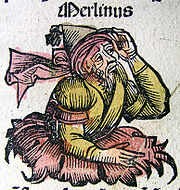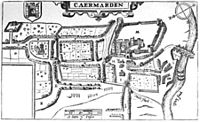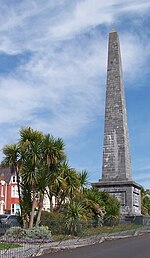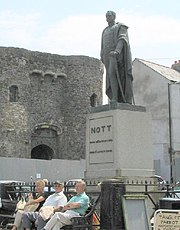Carmarthen
| Carmarthen Welsh: Caerfyrddin | |
| Carmarthenshire | |
|---|---|
 Carmarthen Town Square and Guildhall | |
| Location | |
| Grid reference: | SN415205 |
| Location: | 51°51’22"N, 4°18’58"W |
| Data | |
| Population: | 14,648 (2001) |
| Post town: | Carmarthen |
| Postcode: | SA31-33 |
| Dialling code: | 01267 |
| Local Government | |
| Council: | Carmarthenshire |
| Parliamentary constituency: |
Carmarthen West and South Pembrokeshire |
Carmarthen is the county town of Carmarthenshire. It stands on the River Towy 8 miles north of its mouth at Carmarthen Bay.
Carmarthen lays claim to being the oldest town in Wales but the two settlements of Old and New Carmarthen were only united into a single borough in 1546.[1] Carmarthen was the most populous borough in Wales between the 16th and 18th centuries and was described by William Camden as "the chief citie of the country". However, population growth stagnated by the mid 19th century as more dynamic economic centres developed in the South Wales coalfield.[1]
Arthurian legend

According to some variants of the legend of King Arthur, Merlin was born in a cave outside Carmarthen, with some noting that Merlin may be an anglicised form of Myrddin. Historians generally disagree with this interpretation of the name, preferring that Myrddin is a corruption of an older name used by the Romans, but the story is popular. Many areas surrounding Carmarthen still allude to this, such as the nearby Bryn Myrddin (Merlin's Hill).
Legend also had it that, when a particular tree called 'Merlin's Oak' fell, it would be the downfall of the town as well. In order to stop this, the tree was dug up when it died and pieces are now in the museum. The occasional flooding of the appropriately-named Water Street has been attributed to ongoing redevelopment of the area.
The Black Book of Carmarthen includes poems with references to Myrddin (Ymddiddan Myrddin a Thaliesin) and possibly to Arthur (Pa ŵr yw'r Porthor?). The interpretation of these is difficult because the Arthurian legend was already known by this time and many details of the modern form of the legend had been described by Geoffrey of Monmouth before the book was written. In addition, some of the stories appear to have been moved into Wales at some point before their recording in the book.
Parish church
St Peter's Church is the largest Parish Church in Wales and also has the longest nave being 60 metres from west porch to east window and 15 metres wide across nave and south aisle. It consists of a west tower, nave, chancel, south aisle and a Consistory Court. It is built of local red sandstone and grey shale.
The tower contains eight bells with the heaviest weighing 15cwt-1qr-18 lb; just under one ton.
History
Early history
When Britannia was a Roman province, Carmarthen was the civitas capital of the Demetae tribe and known as Moridunum (from the British language, meaning sea fort). Carmarthen is possibly the oldest town in Wales and was recorded by Ptolemy and in the Antonine Itinerary. The Roman fort is believed to date from 75-77 AD. A coin hoard of Roman currency was found nearby in 2006.[2] Near the fort is one of seven surviving Roman amphitheatres in the United Kingdom and one of only two in Roman Wales (the other being at Isca Augusta; Roman Caerleon). It was excavated in 1968. The arena itself is 151 ft by 89 ft; the circumference of the cavea seating area is 302 ft by 220 ft.[3]
The strategic importance of Carmarthen was such that the Norman William fitz Baldwin built a castle, probably around 1094. The existing castle site is known to have been used since 1105. The castle was destroyed by Llywelyn the Great in 1215. In 1223, the castle was rebuilt and permission was received to wall the town and crenellate (a murage). Carmarthen was among the first mediæval walled towns in Wales. In 1405, the town was taken and the castle was sacked by Owain Glyndŵr.
The famous Black Book of Carmarthen, written around 1250, is associated with the town's Priory of St John the Evangelist and Teulyddog.
During the Black Death of 1347-49, the plague was brought to Carmarthen by the thriving river trade[4]. The Black Death devastated villages such as Llanllwch. Local historians place the plague pit, the site for mass burial of the dead, in the graveyard that adjoins the 'Maes-yr-Ysgol' and 'Llys Model' housing at the rear of St Catherine Street.
Early modern

After the Acts of Union, Carmarthen became the judicial headquarters of the Court of Great Sessions]] for south-west Wales.[5]
Both the Priory and the Friary were abandoned during the dissolution of the monasteries in the reign of Henry VIII, the land being returned to the Crown. The chapels of St Catherine and St Barbara were dissolved too, leaving the church of St Peter's. During the Marian persecutions of the 1550s, Bishop Ferrar of St David's was burnt at the stake in the market square - now Nott Square. A Protestant martyr, his life and death are recorded in John Foxe's famous book of martyrs.
In the 16th and 17th centuries, the dominant business of Carmarthen town was still agriculture and related trades, including woollen manufacture. Carmarthen was made a county corporate by charter of James I in 1604. The charter decreed that Carmarthen should be known as the 'Town of the County of Carmarthen' and should have two sheriffs. This was reduced to one sheriff in 1835 and the (now largely ceremonial) post continues to this day.
18th century to present
In the mid 18th century, the iron and coal trades became much more important although Carmarthen town never developed ironworks on the scale of Dowlais or Merthyr Tydfil. Carmarthen town hosted the National Eisteddfod in 1867, 1911 and 1974 although, at least in the case of the 1974 Eisteddfod, the Maes was at Abergwili.
The Boys' Grammar School was founded in 1587 on the site that is now occupied by the old hospital in Priory Street. This school moved in the 1840s to Priory Row before relocating to Richmond Terrace. It was here at the turn of the century that a local travelling circus was given permission to bury one of their elephants after it fell sick and died. The elephant's final resting place is under what was the school rugby pitch.
During the Second World War, prisoner-of-war camps were situated in Johnstown (where the Davies Estate now stands) and at Glangwilli, where the POW were being used as part of the hospital.
Landmarks
Picton's monument

The original monument, erected in 1828, stood at the west end of the town and was erected in memory of the gallant Sir Thomas Picton, who died in the Battle of Waterloo. It was about 75 foot high and was intended to echo Trajan's column in Rome. The pillar stands on a square pedestal, with a small door on the east side, which fronts the town, where the monument was ascended by a flight of steps. Over the door, in large characters, was the name, 'PICTON' and above this is a relief showing part of the field of battle, with the hero falling from his horse, from the mortal wound which he received. Over this, in large letters, is inscribed 'WATERLOO'. On the west end is represented the Battle of Badajoz (1812), Picton scaling the walls with a few men and attacked by the besieged. Above this is the word 'BADAJOS'. On the south side of the pedestal is an inscription to Picton's life.
On the north side was the translation of the above in Welsh and on the top of the pedestal, on each side of the square, were trophies. The top of the column was also square and on each side were imitative cannons. The statue of the hero surmounts the whole, wrapped in a cloak and supported by a baluster, round which are emblems of spears.
However, within a few years, this monument had fallen into a dilapidated state. The bas-reliefs which had been sculpted by Edward Hodges Baily were 'unable to withstand Carmarthen's inclement weather', as Joyce and Victor Lodwick put it (see 'The Story of Carmarthen' p. 391). Although the sculptor made replacements, they were never put up and the entire monument was taken down in 1846. The replacement sculptures lay neglected and forgotten in Johnstown until the 1970s, when they were rescued and transferred to the Museum.
The monument as it appears today was designed by the architect Frances Fowler and the foundation stone was laid in 1847. This monument, too, has had its troubles. In 1984, the top section was declared to be unsafe and was taken down and, in 1988, the whole monument was rebuilt stone-by-stone on new stronger foundations.
General Nott statue

A statue of General Nott was erected in Nott Square in 1851. According to the PMSA, "the bronze statue was cast from cannon captured at the battle of Maharajpur. Queen Victoria gave 200 guineas to the memorial fund. The statue occupies the site of the market cross which was dismantled when the market was resited and Nott Square created in 1846."[6]
Pont King Morgan
For over a century, the station at Carmarthen town has been isolated from the town on the other side of the River Towy (Tywi) and pedestrians and cyclists had to brave the main road bridge some 200 m to the east. This situation has been rectified by the construction of a cable stay bridge linking the station with the foot of Blue Street.[7]
Picture gallery
-
King Morgan Footbridge
-
The Mount
-
Guildhall Square
-
Carmarthen Castle
-
The Red Dragon
-
St Peter's Church
-
Lammas St
References
- ↑ 1.0 1.1 Davies, John; Jenkins, Nigel (2008). The Welsh Academy Encyclopaedia of Wales. Cardiff: University of Wales Press. p. 123. ISBN 9780708319536.
- ↑ "Roman treasure discovered on farm". BBC News. 17 June 2006. http://news.bbc.co.uk/1/hi/wales/5089504.stm. Retrieved 28 April 2010.
- ↑ G.D.B. Jones, Excavations at Carmarthen, Carmarthenshire Antiquary 5 (1969) 1ff; 6 (1970); The Princeton Encyclopedia of Classical Sites
- ↑ Philip Ziegler, The Black Death, Penguin, 1969, p199
- ↑ Wales and the Law
- ↑ Public Monument and Sculpture Association on General Nott Statue from National Recording Project
- ↑ http://www.lunemillenniumbridge.info/Carmarthen.html






